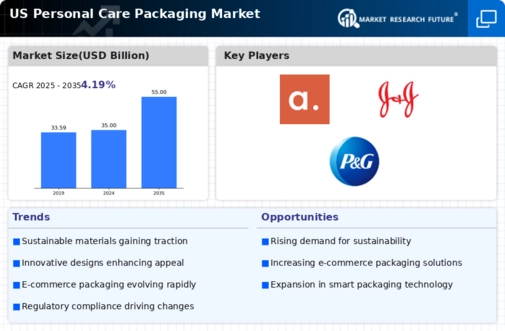Consumer Preference for Customization
Consumer preference for customization is emerging as a significant driver in the personal care-packaging market. As individuals seek products that reflect their unique identities and preferences, brands are increasingly offering personalized packaging solutions. This trend is particularly pronounced among younger consumers, who value individuality and self-expression. In the US, nearly 60% of millennials are willing to pay more for personalized products. This shift is prompting brands to explore innovative packaging designs that allow for customization, such as labels that can be tailored to individual consumers. As a result, the personal care-packaging market is likely to see a rise in bespoke packaging options that cater to this growing demand.
Growth of E-Commerce and Online Retail
The rise of e-commerce and online retail is reshaping the personal care-packaging market, as brands adapt their packaging strategies to meet the demands of online shopping. With an increasing number of consumers purchasing personal care products online, packaging must ensure product safety during transit while also being visually appealing for unboxing experiences. In the US, e-commerce sales in the personal care sector have surged by over 30% in the past year, indicating a shift in consumer purchasing behavior. This trend compels manufacturers to design packaging that is not only protective but also enhances the overall customer experience. Consequently, the personal care-packaging market is evolving to accommodate these new retail dynamics.
Technological Advancements in Packaging
Technological advancements are significantly influencing the personal care-packaging market, as innovations in materials and design enhance product functionality and consumer experience. The integration of smart packaging technologies, such as QR codes and NFC tags, allows brands to engage consumers more effectively by providing information about product usage and sustainability. In the US, the market for smart packaging is projected to grow at a CAGR of 15% over the next five years. This growth indicates a shift towards more interactive and informative packaging solutions, which not only improve consumer engagement but also enhance brand loyalty. As technology continues to evolve, the personal care-packaging market is likely to see further innovations that cater to the tech-savvy consumer.
Rising Demand for Eco-Friendly Solutions
The personal care-packaging market is experiencing a notable shift towards eco-friendly solutions, driven by increasing consumer awareness regarding environmental sustainability. As consumers become more conscious of their ecological footprint, brands are compelled to adopt sustainable packaging materials. In the US, approximately 70% of consumers express a preference for products with environmentally friendly packaging. This trend is prompting manufacturers to explore biodegradable, recyclable, and compostable materials, which not only appeal to eco-conscious consumers but also align with regulatory pressures for reduced plastic waste. the personal care packaging market is evolving to meet these demands, with companies investing in innovative materials that minimize environmental impact while maintaining product integrity.
Regulatory Pressures for Sustainable Practices
Regulatory pressures are playing a crucial role in shaping the personal care-packaging market, as governments implement stricter guidelines aimed at reducing plastic waste and promoting sustainable practices. In the US, recent legislation has mandated that companies reduce single-use plastics and increase the recyclability of their packaging. This regulatory environment is compelling brands to rethink their packaging strategies and invest in sustainable alternatives. As a result, the personal care-packaging market is witnessing a shift towards materials that comply with these regulations, such as recycled plastics and biodegradable options. This trend not only addresses environmental concerns but also positions brands favorably in the eyes of increasingly eco-conscious consumers.














Leave a Comment